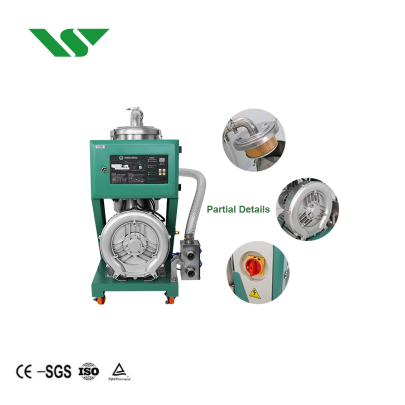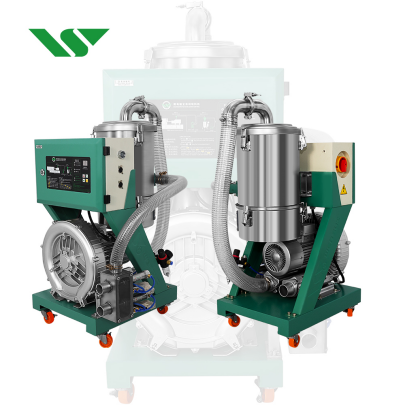Why Every Plastic Factory Should Invest in a Raw Material Autoloader
2025-05-10 Page view:
If you're in the plastic manufacturing business, you may have heard about raw material autoloaders. These machines are quickly becoming essential in modern factories, and for good reason. In this article, I’ll break down the importance of autoloaders, how they function, and why they’re a game-changer for plastic manufacturing. Let’s dive into how they can streamline operations, reduce costs, and boost productivity.

What is a Raw Material Autoloader?
In simple terms, a plastic raw material autoloader is a device that automatically transports plastic materials like pellets, granules, or powders from storage to the processing machines. Instead of relying on manual labor to move these materials, autoloaders use vacuum or pneumatic systems to deliver the materials directly to the machines that need them. This means no more workers manually scooping and carrying materials—autoloaders handle it all, making your factory more efficient.
Autoloaders come in various models to suit different factory setups, whether you're dealing with small, single-machine operations or large, multi-machine systems. Whether they are standalone units or part of a larger network, autoloaders help ensure that the right material gets to the right machine at the right time, reducing labor and errors.
Why Autoloaders Are Essential for Plastic Factories
Autoloaders offer numerous benefits that can significantly improve the efficiency of your factory. Here’s why they are indispensable:
Increased Efficiency: Autoloaders save a lot of time by eliminating the need for workers to manually refill hoppers. Once installed, they provide a continuous flow of materials, keeping machines running smoothly without interruptions.
Cost Savings: While the initial cost of an autoloader might seem significant, the long-term savings are substantial. Autoloaders reduce labor costs by decreasing the number of workers needed for manual material handling. Additionally, they help prevent material waste by minimizing spillage and overfilling.
Consistent Production: Autoloaders ensure a steady, uninterrupted flow of materials to your machines, meaning less downtime and more consistent product quality. Without them, material shortages or mismanagement can lead to defects or delays.
Reduced Manual Labor: Transporting heavy bags of plastic materials is physically demanding and can lead to workplace injuries. Autoloaders take on this heavy lifting, allowing workers to focus on more skilled tasks, which can boost morale and reduce turnover.
Environmental Benefits: Modern autoloaders are designed to minimize dust and contamination, which keeps your workspace cleaner. By ensuring that materials are properly transported without unnecessary spillage, they contribute to reducing environmental waste.
These are real benefits I’ve seen firsthand in factories across various sizes. Whether you're operating a small shop or a large industrial facility, plastic autoloaders can improve your business by making it more efficient and cost-effective.

How Autoloaders Function
To truly understand the value of an raw material loader it's important to know how they work. Essentially, these machines use a vacuum system to suck the plastic materials through tubes and deliver them to the machines. Here's a quick overview:
The autoloader is connected to a material storage container, such as a silo or hopper.
A vacuum pump or blower creates suction, drawing materials through flexible hoses to a receiver unit.
The receiver unit is equipped with a filter to remove dust and ensure that only clean material enters the processing machine.
Once the hopper is full, the system pauses and will only resume when more material is needed.
This simple, yet efficient, setup ensures that materials are delivered exactly when needed, and that overfilling or shortages are avoided. Some advanced autoloaders even integrate with your factory's control systems, allowing you to monitor and adjust settings remotely for maximum efficiency.
Key Features to Consider When Choosing an Autoloader
When selecting an autoloader for your factory, it’s important to choose one that matches your specific needs. Here are the key features you should look for:
Capacity and Throughput: Choose an autoloader that can handle the volume of materials you use. For smaller operations, you may need a model with a capacity of 100-200 kg/hour, while larger factories may need systems capable of handling 1000 kg/hour or more.
Material Compatibility: Make sure the autoloader is compatible with the types of materials you use. Some machines are specially designed to handle sensitive materials like hygroscopic resins or abrasive powders without causing damage or clogs.
Ease of Maintenance: Look for autoloaders with easy-to-clean components, such as quick-release filters and removable parts, to save time during maintenance.
Control Systems: The best autoloaders have intuitive controls, such as digital displays and programmable settings. Some models even offer remote monitoring, which can be incredibly useful if you're managing multiple machines.
Durability: Choose an autoloader made from high-quality, durable materials like stainless steel to withstand the wear and tear of constant use.
Noise Levels: If noise is a concern in your factory, look for autoloaders with built-in sound-dampening features.

Tips for Selecting the Right Autoloader for Your Factory
Choosing the right autoloader can be overwhelming, but these practical tips should help:
Evaluate Your Needs: Consider your production volume, the types of materials you use, and the number of machines in your factory. Smaller factories may benefit from standalone units, while larger operations may require a centralized system.
Set a Realistic Budget: While the upfront cost of an autoloader is important, think about long-term savings from reduced labor and waste. Be sure to factor in maintenance and energy costs.
Check Compatibility: Make sure the autoloader integrates well with your existing equipment, including hoppers and machines. It’s important to avoid compatibility issues that can delay installation.
Request a Demo: If possible, ask the supplier for a demo or trial run to see the autoloader in action. This can help you gauge its user-friendliness and reliability.
Consider Scalability: Choose an autoloader that can grow with your business. If you plan to expand, look for a system that can handle higher capacities or more machines in the future.
Conclusion
Raw material autoloaders are more than just a convenience—they’re an essential tool for any plastic manufacturing facility aiming to stay competitive. They streamline operations, cut costs, and improve production consistency, all while reducing manual labor and waste. By choosing the right plastic autoloader for your needs, you can enhance your factory’s efficiency and set it up for long-term success.
If you’re ready to upgrade your operations, start by assessing your factory’s requirements and explore the autoloader options available. Once you see how these machines work, you’ll wonder how you ever managed without them!



